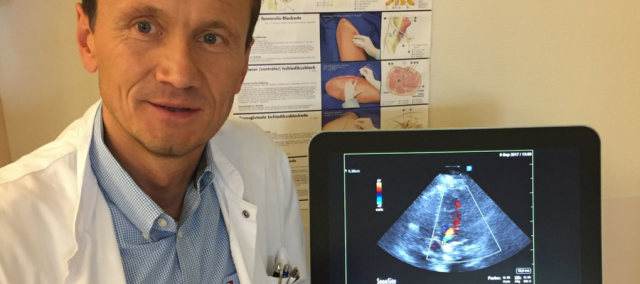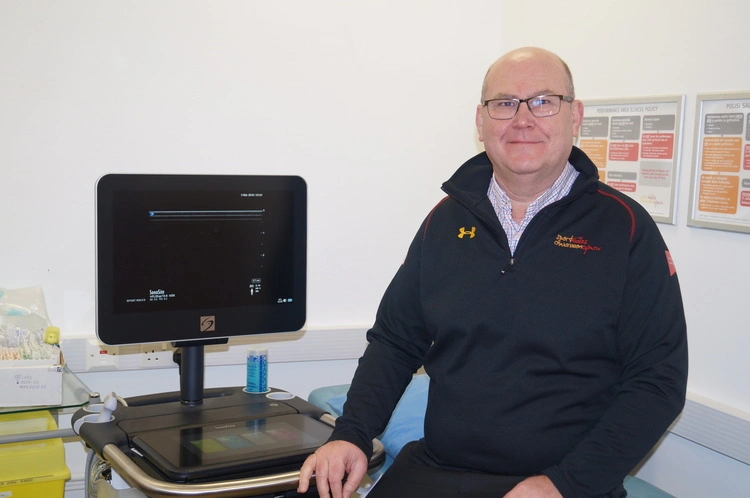
Point-of-care ultrasound is an essential tool for Dr. Mark Ridgewell, an early pioneer of sport and exercise medicine (SEM). Through the course of his career, Mark has worked with many amateur and professional sportsmen and women, beginning with rugby and including three years with England Cricket and eight years with the Wales football team.
The first SEM consultant to be registered in Wales, Dr. Ridgewell continues to work with the LTA and WTA women’s tennis tour every summer, and with Welsh Olympic and Commonwealth athletes across many sports under the Sport Wales banner. Mark also leads an NHS Musculoskeletal Assessment Service at the Abertawe Bro Morgannwg Health Board in Swansea, and is the Principal Lecturer on the Cardiff Metropolitan University’s Sport and Exercise Medicine course, which he helped set up in the late 1990s.
In a brief essay, he explains how point-of-care ultrasound has become increasingly important in sports and exercise medicine in recent years.
My first foray into sports medicine was an introductory BASEM course in 1988. At that time, there was no clear career progression for SEM as a specialty in its own right and, in 1991, I became a GP. In the same year, I started working in high-level rugby at Swansea Rugby Club, alongside a senior orthopaedic consultant, a physiotherapist and an experienced GP.
In those early days, this was largely first aid and trauma management, providing pitch side cover, stitching cuts and looking after acute injuries as they happened. I continued along this path, completing a Masters in Sport and Exercise Medicine at the University of Bath in 2000 and, over the 13 years I spent at Swansea Rugby, the game turned professional and the medic’s role became far more involved. Rugby was a fantastic sport to start with because, unfortunately, there are so many injuries.
However, over time I branched out to cover international cricket, football and, after joining Sport Wales in 2003, have dealt with all kinds of sports. Working with Welsh Olympic and Commonwealth athletes in sports as diverse as athletics, cycling, gymnastics, swimming, netball, and disability sports has undoubtedly helped me to become a much better sports doctor.
In my experience, point-of-care musculoskeletal ultrasound has developed into an extremely useful tool for SEM, particularly in the last 10 years; it has certainly become indispensable for me. Patients today are well read and educated, and they will simply take themselves elsewhere if there isn’t access to this sort of state-of-the-art technology, and if the person using that technology isn’t completely competent and confident in what they are doing.
I have been a Consultant Sports Physician at the Sport Wales Institute for the past 13 years and these days a consultation is often more of a discussion about how to manage an injury – whether it’s a broken bone or a ruptured ligament.
The beauty of ultrasound is that it gives you the ability to explain things to individual athletes. They are generally very interested in the imaging, particularly on the Cardiff High Performance Centre’s new X-Porte® system – which has a large screen and offers excellent image clarity. It is excellent for, for example, assessing tendons during rehabilitation and recovery following an injury, or looking at injuries dynamically, to work out what’s happening when a joint or the tendons move.
Soft tissue overuse injuries are often a lot more subtle and more difficult to explain, and the ability to use ultrasound is a huge benefit here. We also use ultrasound regularly for guiding injections, particularly in shoulders, hips and around the ankle.
I first had the opportunity to use ultrasound on a regular basis when Sport Wales bought its first Sonosite system – a MicroMaxx® – in 2006, and this steady access to point-of-care technology was key to cultivating my scanning skills. Since this time, continual education and training have helped me to develop my own skills, and I am currently studying to complete a postgraduate diploma in musculoskeletal ultrasound in Bournemouth University in association with the AECC.
I still regularly attend focused ultrasound courses – both in the UK and internationally – as keeping up-to-date is extremely important; the elite sports world is constantly changing and you can’t be left behind.
As such a multidisciplinary specialty, being able to work alongside high level physios and doctors, highly qualified and experienced people from different backgrounds, has hugely benefited my own understanding. Even though I’ve been doing this for a long time, training and knowing your limitations are absolutely paramount; I am constantly looking at new ways to help and support my patients. I continue to try to improve and develop my skills and ensure that they fit clinical governance standards and that is the reason for doing the postgraduate diploma in Bournemouth.
Overall, there is no question that point-of-care ultrasound has probably been one of the biggest advances for me in the last 10 years. Sonosite’s X-Porte system is a fantastic machine in terms of image quality and ease of use, and we still have the MicroMaxx which we use for scanning at the training grounds or pitch side.
Learn More About the Sonosite X-Porte
Easily manoeuvre around beds and exam tables for point-of-care imaging, the Sonosite X-Porte is engineered for portability and durability. During transport, X-Porte’s screen folds down and its stand lowers making it even more compact for navigating busy corridors.



